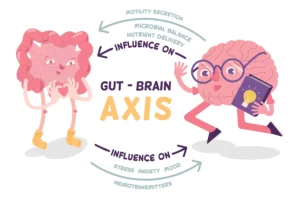The bidirectional communication network of the GBA comprises the central nervous system (CNS), the autonomic nervous system (ANS), the enteric nervous system (ENS) - often referred to as the ‘second brain’ due to its extensive network of neurons in the GI tract - and the hypothalamic-pituitary-adrenal axis.2,3

Typically, communication from the gut to the CNS occurs autonomously and goes unnoticed by the individual. However, in pathological conditions such as IBS, signals may extend to the somatic sensory system, resulting in symptoms like discomfort, nausea, and pain. Conversely, the CNS output through the ANS can contribute to GI dysfunction.2
The gut-brain axis and neurotransmitters
Microbial molecules transmit signals to the brain via vagal and afferent nerve pathways, as well as through cytokines and neurotransmitters. Gamma-aminobutyric acid (GABA), the major inhibitory neurotransmitter in the CNS, is found not only in the brain but also in the GI track. It reduces neuronal excitability and has been linked to various physiological functions in the GI tract including IBS.2,3,4
GABA serves diverse functions in the GI track, including modulating visceral nociception, colonic afferent excitability, GI secretion, motility, and supporting the local immune system.5
GABA transporters (GAT) in the gut, such as GAT2 in enteric glia cells and GAT3 in myenteric neurons, regulate GABAergic signalling. Altered GABA levels are associated with inflammatory diseases, including decreased levels in multiple sclerosis, ischaemic stroke, and ulcerative colitis.5
In patients with IBS, particularly IBS-Diarrhoea subtype, GABA, glutamic acid decarboxylase 2, GABA-B receptors, and GAT-2 are dysregulated, suggesting a link between stress-induced GABAergic alterations and IBS pathogenesis.5
Chronic pelvic pain patients with lower GABA levels in the anterior cingulate cortex highlight the association between GABA and visceral pain hypersensitivity, a key symptom in IBS.5
Anxiety disorders or stress, commonly comorbid with IBS, show increased GABA levels in the prefrontal cortex in severe cases, indicating a potential link between GABAergic alterations and anxiety-related IBS manifestations.5
Interplay with other neurotransmitters
While GABA is a significant player, the GBA involves a complex interplay of various neurotransmitters. Other key neurotransmitters associated with IBS include:3,5
- Serotonin (5-HT): Abnormalities in serotonin signalling have long been implicated in IBS. Serotonin regulates bowel movements, and alterations in its levels or receptor sensitivity may contribute to IBS symptoms.
- Dopamine: Dopaminergic pathways are also involved in gut motility and sensation. Imbalances in dopamine levels may impact the GBA and contribute to IBS symptoms.
- Glutamate: As the primary excitatory neurotransmitter in the CNS, glutamate plays a role in pain perception. Changes in glutamatergic signalling may contribute to visceral hypersensitivity seen in IBS.
- Acetylcholine: Involved in smooth muscle contraction, acetylcholine abnormalities may influence gut motility. Dysregulation in cholinergic signalling is associated with IBS.
- Histamine: Histamine receptors are present in the gut and are involved in immune responses. Histamine dysregulation may contribute to GI symptoms in IBS.
- Norepinephrine: In the peripheral nervous system, noradrenergic neurons respond to stress, impacting various physiological functions. In the gut, norephinephrine affects digestive function through β3-receptors, leading to reduced motility. However, acute stress stimulates colonic contractile activity, influencing defecation. Dysregulation of norephinephrine in IBS involves α2A-adrenoceptor alterations, impacting colonic norephinephrine release.
Potential therapeutic implications
Understanding the role of neurotransmitters, including GABA, in IBS opens avenues for potential therapeutic interventions. Targeting neurotransmitter systems could offer novel approaches to manage symptoms and improve the quality of life for individuals with IBS.
Pharmacotherapy modulating GABAergic neurotransmission or targeting other neurotransmitter systems may be explored. However, developing drugs that specifically target the gut without affecting the central nervous system poses a challenge.
Probiotics, which influence the gut microbiota, have shown promise in managing IBS symptoms. The gut microbiota can impact neurotransmitter production and signalling, providing a potential avenue for intervention.
Certain dietary components, such as fermented foods and prebiotics, may positively influence GABAergic neurotransmission. Dietary strategies focusing on neurotransmitter modulation could complement existing treatments.4
Conclusion
The GBA and the role of neurotransmitters, including GABA, in the pathophysiology of IBS highlight the intricate connection between the gut and the CNS.
References
- Chen M, Ruan G, Chen L, et al. Neurotransmitter and Intestinal Interactions: Focus on the Microbiota-Gut-Brain Axis in Irritable Bowel Syndrome. Front Endocrinol, 2022.
- Raskov H, Burcharth J, Pommergaard H-C, et al. Irritable bowel syndrome, the microbiota and the gut-brain axis. Gut Microbes, 2016.
- Mayer EA, Savidge T, Shulman, RJ. Brain-gut microbiome interactions and functional bowel disorders. Gastroenterology, 2014.
- Barbara G, Feinle-Bisset C, Ghoshal UC. The Intestinal Microenvironment and Functional Gastrointestinal Disorders. Gastroenterology, 2016.
- Gros M, Gros B, Mesonero JE, Latorre E. Neurotransmitter Dysfunction in Irritable Bowel Syndrome: Emerging Approaches for Management. J Clin Med, 2021.








